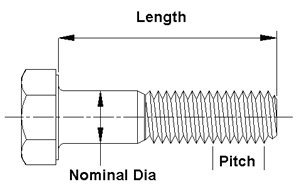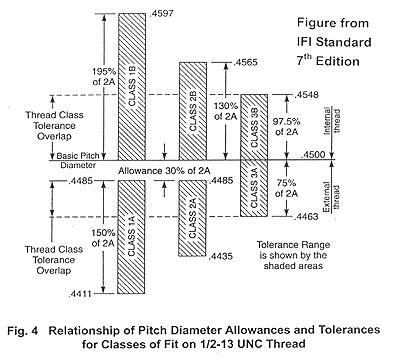|
|
 |
| |
無標題文件

|
|
|
Popular Specifications of Fastener Products top
The following are worldwide standards that are popular applied in manufacturing fastener goods:
| ASTM |
American Society for Testing and Materials |
| ANSI |
American National Standard Institute |
| AISI |
American Iron and Steel Institute |
| IFI |
Industrial Fastener Institute |
| DIN |
Deutches Institue fur Normung |
| ISO |
International Organization for Standardization |
| JIS |
Japanese Industrial Standard |
|
|
How to describe a bolt top
When inquiring a bolt product, it is necessary to note the supplier the requested information such as material, and size. Below is how we say the size of a bolt:
 |
Inch Product |
1/2 |

|
13 |
X |
3" |

|
Nominal dia |

|
Thread pitch per inch |

|
Length |
 |

|

|

|
 |

|
Metric Product |
M12 |

|
1.75 |
X |
60 |

|
Nominal dia |

|
Thread pitch length |

|
Length |
|
|
Thread Design top
The fasteners we produce are required to pass gage tests, except woodscrews.
Besides coarse thread and fine thread, and the gauging systems differs as below:
 |

|
Hex Cap Screw |
Carriage Bolt |
Socket head Cap Screw |
Inch Products |
2A |
2A |
3A |
Metric Products |
6g |
8g |
6g |
|
|
Qualifications: top
Tong Hwei has been accrediated by ISO 9001:2015 Quality Management System & ISO/IEC 17025:2005 The Competence of Testing and Calibration Laboratories. We pay high attention to our manufacturing procedure and product qualities.
|
The Standards of Our Products: top
As a qualified supplier, Tong Hwei products are manufactured according to the following specifications:
Hex Head Cap Screws/Bolts--ASTM F593, ANSI B 18.2.1, DIN933/931
Woodscrews--ANSI B. 18.2.1 ; DIN571
Carriage bolts --ANSI B 18.5; DIN 603
Hex Socket Head Screws--ANSI B18.3
Machine Screws--ANSI B 18.6.3
|
Bolt Inspection & Standards: top
Instead of gage tests, bolts are required to have dimension measurements. Following are the details:
Inspection & Measurement:
| 1. |
Dimensions: |
|
Measuring Instruments--Micrometer , Caliper
Measuring Dimensions--length, head height, head dimension, major diameter, thread length, width across flats, width across corner |
| 2. |
Mechanical Properties: |
| |
Mechanical Properties--Material Testing Machine, Rockwell Hardness Tester
Testing Properties: Tensile Strength(KSI , N/mm 2 ) , Yield Strength ( 0.2% Offset ) (KSI, N/mm 2 ) , Core Hardness(HRB, HRC)
|
Test method: top
1. Mechanical Properties: ASTM F606/F 606M-02
Standard Test Methods for Determining the Mechanical Properties of Externally and Internally Threaded Fasteners, Washers, and Rivets
2. Visual Appearance:ASTM F788/F 788M- 02
Standard Specification for Surface Discontinuities of Bolts, Screws, and Studs, Inch and Metric Series
|
|
What is stainless steel? top
Stainless steel is the generic name for numerous steels used primarily for their resistance to corrosion. Generally speaking, the key element they all share is a minimum percentage of chromium: 10.5%. Although other elements, particularly nickel and molybdenum, are added to improve corrosion resistance, chromium is always the deciding factor. The majority of applied steel in the world is carbon and alloy steel while the much expensive stainless steel shares a small but valuable market.
Why Stainless Steel? top
Stainless steel is not actually free from rust. However, it is famous for its remarkable effort in corrosion resistance. When exposing to the air, carbon steels are easily to be found pitted and oxidized which is the start to corrosion. Conversely, stainless steel, in the same condition as carbon steel, produces chromium oxide (Cr 2 O 3 ) on the surface which protects stainless steel from acid damages and extend the product usage.
Who applies Stainless Steel? top
Stainless steel is found everywhere in our daily lives, for example, knives, kitchenware, and storage system. There are over 180 different kinds of stainless steel in the world, and they can be widely adopted in industries. Following are some common usage in industries:
| * |
Food production and storage system corrosion resistance is doubtless an important key when building food storage systems, and 300 series material, due to its superior performance, is a better choice. |
| * |
House ware, kitchenware the most popular 300 series material is often used not only for its resistance to corrosion but also its convenience to clean. |
| * |
Textile industry regarding its high quality in manufacturing, stainless steel is good selection for textile machines. |
| * |
Medical equipments both 300 and 400series are commonly seen in the industry. |
| * |
Aero industry the 600 series is harder than other stainless steels, which has less problems in galling and seizing. |
| * |
Vehicles grade 400 series mills are often used in the exhaust systems |
| * |
Pumping & oil industry outstanding performance in acid, water, vapor, makes stainless steel much advantageous in this industry. |
|
Where to find Stainless Steel fasteners? top
The corrosion resistance of stainless steel appears not merely notable in normal environment, but also significant in under special conditions, for example, acids, chemicals, and seawaters. The need for stainless steel fasteners is rising, and it is a popular material in many industries:
| * |
Marine industry |
 |
| * |
Chemical Industry |
| * |
Food equipment |
| * |
Building decoration |
| * |
Medical equipment |
| * |
Public transportation system |
| * |
Electrical products |
| * |
Household applications |
| * |
Pumps, compressors and valves |
|
Main Stainless Steel Materials top |
There are four kinds of stainless steel popular used, and their corrosion resistance performances are as below:
Austenitic Stainless Steel >Precipitation Hardened Stainless Steel >
Ferritic Stainless Steel> Martensitic Stainless Steel |
| 1. |
Austenitic Stainless Steel: Main product of this kind of stainless steel is the 18-8 300 series product. It is a cold working product to strengthen its mechanical properties, and regarding its outstanding corrosion resistance quality, it is widely used in the industries. |
| 2. |
Martensitic Stainless Steel: The most well-known stainless steel of this kind is 410 material. It contents less Nickel and Chromium than Austenitic stainless steel, and unlike Austenitic Stainless Steel, its mechanical quality is enhanced through heat treatment. Though it shows excellent in mechanical efforts, its corrosion resistance performance is not that good on the other hand. |
| 3. |
Ferritic Stainless Steel: 430 series is a very popular kind of this Steel. Same as Austenitic Steel, it is a cold working product with very little Nickel, which allows it to be better in price but worse in corrosion resistance. |
| 4. |
Precipitation Hardened Stainless Steel: With AISI coded 600 series, this kind of stainless steel is a modification based on 17-7 Austenitic Steel. The character of it is its high hardness. This kind of stainless steel is highly adopted in the aero industry. |
Chemical Composition Requirements top
Grade |
AISI No. |
C |
Si |
Mn |
P |
S |
Cr |
Ni |
Mo |
A2 |
S30400 |
0.08 |
1.0 |
2.0 |
0.05 |
0.03 |
17.0-20.0 |
8.0-13.0 |
-- |
A4 |
S31600 |
0.08 |
1.0 |
2.0 |
0.05 |
0.03 |
16.0-18.5 |
10.0-14.4 |
2.0-3.0 |
C1 |
S41000 |
0.15 |
1.0 |
1.0 |
0.05 |
0.03 |
11.5-14.0 |
1.0 |
-- |
F1 |
S43000 |
0.04 |
1.0 |
1.0 |
0.04 |
0.03 |
16.0-18.0 |
-- |
-- |
Maximum values % |
|
| | |


1.gif)
1.gif)